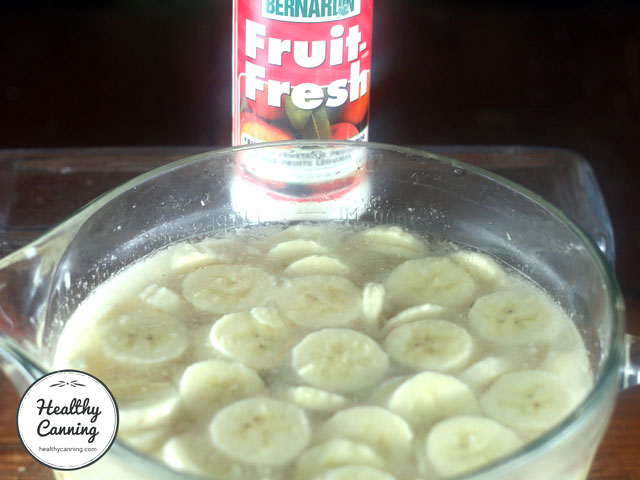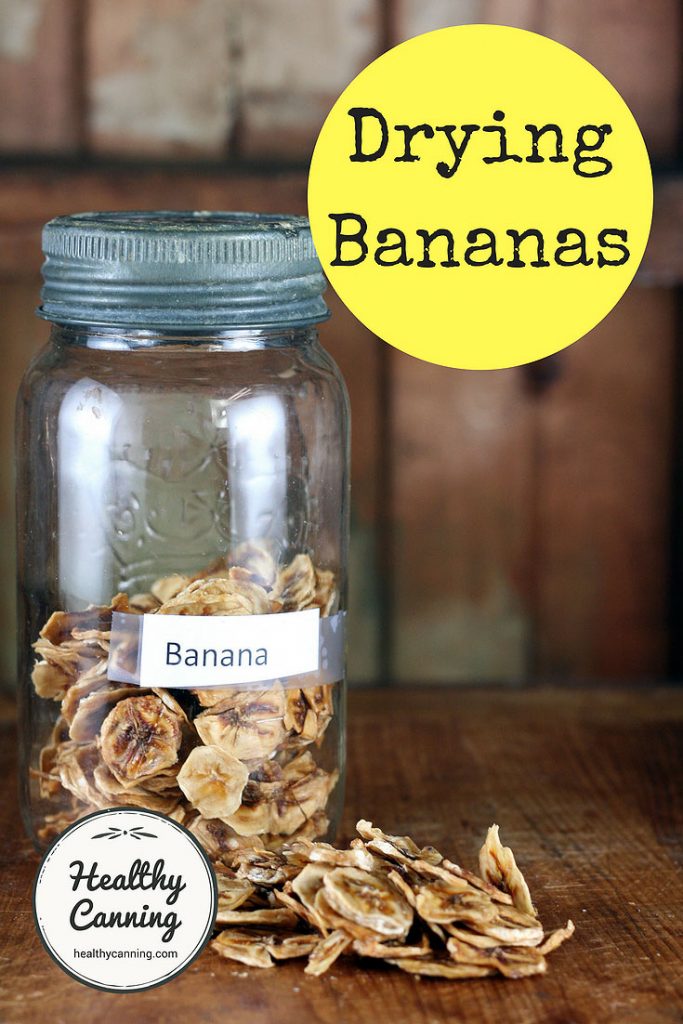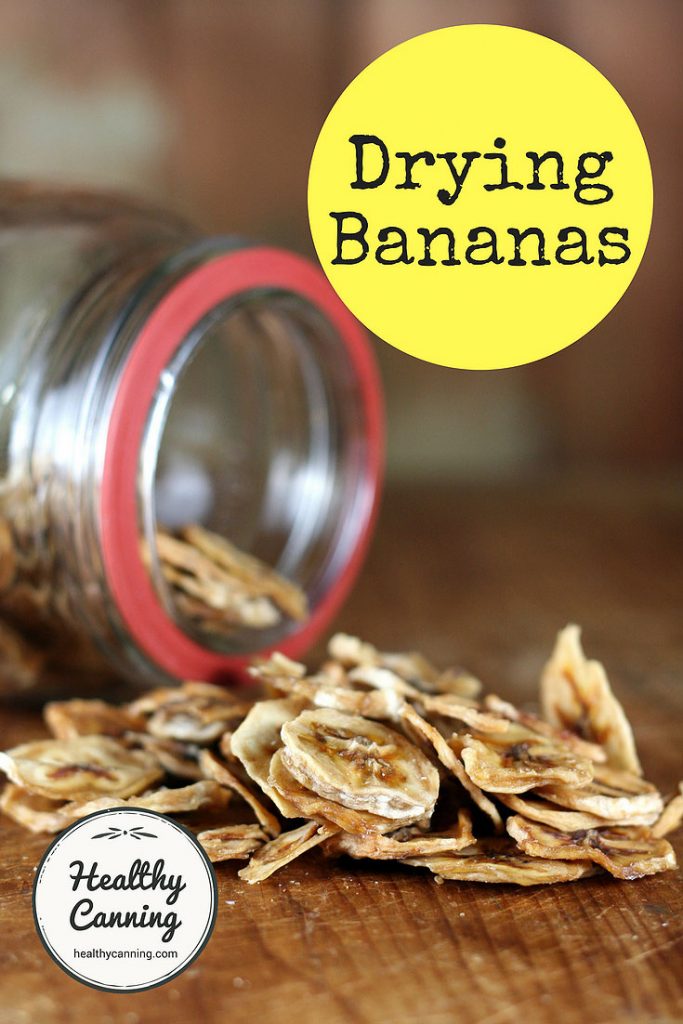Bananas are among the more popular home-dehydrating products to make. They are inexpensive at any time of year, can often be bought on sale, and it’s easy to turn them into a successful, multi-use dried product.
See also: Canning Bananas?
Yields and Equivalents
1 pound dried sliced Bananas = 450 g = 4 – 4 ½ cups dried
For a bunch of 8 standard (cavendish) bananas, weighing about 1 ¼ kg (2.75 lbs) whole before peeling, allow 2 standard Excalibur trays to spread the slices out on.
Directions
Here we compare directions from three different sources.
For information on making the dips mentioned below, see Fruit dry-pretreatments .
Ball Blue Book
Preparation: “Peel and cut into ¼- to ½- inch (½ to 1 cm) inch slices.”
Pretreatment: “Pretreat with Fruit-Fresh by dipping, if desired.”
Temperature: 130 to 135 F (54 to 57 C)
Time: Until pliable to almost crisp.
Notes: “Choose any large, slightly brown-speckled yellow variety.”
Water content: 76%. (Used if doing a Dehydration Weight Test.)
Reference: Ball Blue Book, 37th edition, 2014. Page 164.
Note: Ball All New (2016) says “Choose large fruit with a few brown spots. Peel, cut into ¼- to ½- inch (½ to 1 cm) slices. Treat with Ball Fruit-Fresh.” Dry until “pliable with crisp edges.” (Page 336)

Banana resting in Fruit Fresh for 3 to 5 minutes. 1 tbsp Fruit Fresh per 1 litre / quart water. Add another tablespoon of Fruit Fresh every other use.
Excalibur
Preparation: “Peel the bananas and cut into ⅛″ to ¼″ (¼ to ½ cm) slices. Cut away any bruised portions.”
Pretreatment: “Bananas may be sprinkled with fruit flavoured gelatin powder or lemon juice. Honey dip for crisper slices.”
Temperature: 135 F / 57 C
Time: “Until leathery.” (6 to 10 hours based on humidity conditions where you are.)
Notes: “Large yellow varieties, like Cavandish or Martinique, dehydrate best. Those that are all yellow or lightly brown specked will be the sweetest; avoid green or overripe bananas.”
Quality: Excellent
Reference: Excalibur. Preserve it naturally. 4th edition, 2012. Page 25 and 39.
So Easy To Preserve
Preparation: “Peel and slice ¼ inch to ⅜th inch (½ to ¾ cm) thick, crosswise or lengthwise.”
Pretreatment: Sulfur smoke 2 hours OR steam blanch 3 to 4 minutes OR syrup 10 minutes OR honey dip, ascorbic acid, Fruit Fresh, fruit juice, or, sulfite dip.
Temperature: 140 F / 60 C
Time: 8 to 10 hours
Notes: “Use solid yellow or slightly brown-flecked bananas. Avoid bruised or overripe bananas.”
Quality: Good.
Reference: So Easy To Preserve. 6th Edition. 2014. Page 343.
Notes
Here’s a FAQtoid on banana chips from the National Center for Home Food Preservation:
Q: My banana chips don’t taste like the ones in the stores. What can I do?
A: There are a variety of banana chips available. Read the ingredients on the label. Some bananas are dipped in honey; some are dipped in granulated sugar, brown sugar or flavored gelatin. Be sure bananas are ripe. Some commercial banana chips have been treated to make them crisp. This cannot be done in the home.” [1]NCHFP Drying FAQ. Accessed January 2018.
Reference information
Blanching times for drying fruit
Storage
Let the dehydrated product cool completely to room temperature before packing it into storage containers.
Watch the sealed containers for the first few days for any sign of condensation. If condensation occurs, dehydrate a bit more.
Label jar with name of product and date. Store away from heat and direct light.
Usage notes
Use in breads, cakes, cereals, compotes, cookies, fritters, muffins, pancakes, trail mixes, or as a snack out of hand.
Or, grind up and use as a topping on cakes, muffins and baked puddings, etc.
Or grind more finely into a powder and use as a flavouring ingredient in recipes and in hot drinks such as cocoa.
Further reading
Things to do with Dried Bananas
Dandamrongrak, Rak, Gordon Young, and Richard Mason. “Evaluation of Various Pre-Treatments for the Dehydration of Banana and Selection of Suitable Drying Models.” Journal of Food Engineering 55 (2002): 139–146. Web.
References



Hippie Gardener
Wouldn’t orange juice of lemon juice work just as well as the Fruit Fresh? We have also tried MCT oil and naked with no coating. Both work fine if in our dehydrator.
Ela
This whole website is absolutely fabulous!!!!! So much information, backed up with more information and so much more. I like canning and dehydrating.
To put all this together and keep up with updates takes a lot of time and effort. Thank you sooo very, very much for doing it so, and offer for free.
Sincerely,
your reader and user 🙂